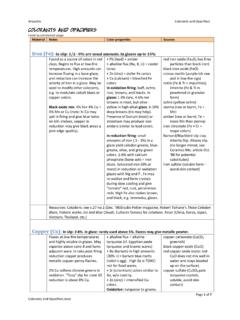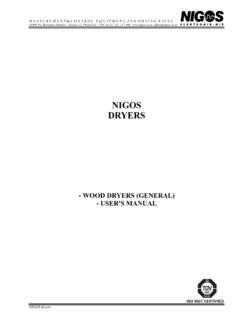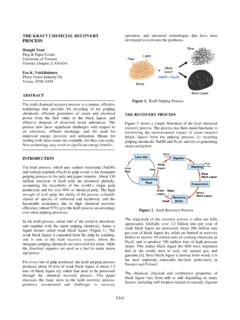Transcription of Basic Ceramic Vocabulary Arbuckle - Linda Arbuckle Ceramics
1 Basic Ceramic Vocabulary Arbuckle 212 degrees F Temperature where water turns to steam and there is potential for that steam to blow up greenware during too-rapid firing. 451 degrees F Temperature where cristobalite inversion occurs, with a sudden change in size of 2%. Ceramic works, especially high-fired ware, should be cooled slowly through this point. 451 is the temperature where paper burns. If you put paper into the kiln peep hole, and it chars or bursts into flame, you're above 451. and it's too hold to open the kiln for faster cooling. 1000 degrees F Visible red heat. Quartz inversion.
2 Bisque fire An initial firing of raw clay ware to burn out physical water, chemical water, and carbonaceous matter, and make the clay into a material that will not slake down in water and may more easily be glazed. Sometimes called biscuit firing in Europe. bisqueware Clay ware that has been fired once. Common studio practice is to bisque lower than the glaze maturity temperature to keep the body porous enough to accept glaze. Bisque ware will no longer slake down in water. Some commercial clay processes, especially fine porcelains, involve high bisque of supported ware, with a lower glaze firing.
3 Bone-dry Unfired clay with as much atmospheric water evaporated as relative humidity permits. The piece is dry, light in color, and very fragile. Clay in this state will slake down completely in water to an amorphous mass. centering Using your hand on the potters' wheel to move a dome of clay into a balanced position in the center of the wheel head or batt in preparation for raising a wall or other shaping. chemical water Water combined with other materials in molecules. The molecular bonds are broken during heating, and water vapor is given off between about 660-1470 degrees F.
4 Clay contains about 14% chemical water by weight. clay Material formed from decomposed granitic rock. Clay particles have a flat, plate-like structure. Raw, wetted clay is plastic and has the ability to be formed through pressure. Raw, bone-dry clay will slake down if re-wetted and may be re-used. Once fired, the Ceramic material is in a bisque state, where it is hard and will no longer slake down in water. Glaze is usually applied at this state, and the work fired again to the glaze maturity temperature. The formula for raw clay is Al2O3z2 SiO2z2H2O. clay body Mixture of various clays, fluxes, and fillers to have the desired color, working properties, and firing temperature.
5 Combing Slip decoration method of dragging a coarse toothed tool or fingers through damp slip. Page 1 of 6. Basic Ceramic Vocabulary Arbuckle cone pack A small pad of clay with visual cones to measure firing progress. A standard 3-cone pack has a guide cone (one cone before the desired cone), a firing cone (the desired cone), and a guard cone (one cone higher than the desired temperature. The cones are put in a low pad of clay, leaning 8 degrees (as the bottom of the cone leans), with the cone that melts first in front. The kiln in the kiln sitter produces a cone LOWER at 3 o'clock in a visual cone pack because the sitter cone is horizontal with a bar on it and melts sooner due to those conditions.)
6 An 03 cone in the sitter will produce an 04 cone bent at 3 o'clock. Small junior cones are used in kiln sitters and for electric firing. Large standard cones are used in gas firings, where the kilns generally have larger peep holes, and the large cones are easier to see in a hot kiln atmosphere. If you are firing more than a cone or 2 above the first cone, (common for high-fire reduction, left) you must make a boat at the end of your cone pack to catch the melted cone. crawling Condition where the glaze rolls back during firing and leaves bare patches on the body. May be caused by overly thick glaze, or dust, wax, or oil on the surface of the bisque ware.
7 Crazing When a glaze shrinks more than the clay body it is on, causing cracks in the glaze. This is sometimes called crackle when done deliberately for decorative effect. Crazed glazes on a porous body (lowfire) will seep liquids. deflocculated A condition where the clay particles have a negative charge and repel each other. This causes a parallel, deck of cards particle orientation. Good for brushing and slip-casting. Makes a solution containing clay liquid with less water. Settles into a compact mass in the bottom of the bucket. Runs off your hand to leave a very thin layer at normal glaze consistency.
8 Materials used as deflocculants: sodium silicate, soda ash, Darvan. Materials in a glaze or slip that cause deflocculation: nepheline syenite, wood ash, lithium carbonate, some frits (notably 3110), soft water. dry foot The practice of leaving the bottom of a Ceramic piece unglazed so it may sit directly on the kiln shelf without sticking. dunting Cracking thru the body and glaze during cooling due to the stresses between the body and the glaze and/or thermal shock cooling. Dunted pieces will have very sharp edges at the break. earthenware Lowfire clay body that is not vitrified at maturity.
9 May be white, buff, or red in color. Buff and red earthenware bodies occur naturally; white lowfire bodies are man-made. extrusion Plastic clay that has been forced through a die to change its shape. May be solid or hollow. flocculated a condition where the clay particles in a solution have a charge that attracts them end-to-middle, producing a house of cards open lattice. This is good for dipping glazes, and means that although glazes settle, they do no compact in the bucket. A flocculated glaze coats your hand well at normal glaze thickness. Epsom salt solution flocculates mixtures with clay in them.
10 Flux A material that helps promote a melt of a mix of Ceramic materials. Page 2 of 6. Basic Ceramic Vocabulary Arbuckle glaze Glassy melted coating fired on to Ceramic object for visual or functional purposes. Glassformer + viscosity agent + flux. May be glossy, satin, or matte surface. gloss A shiny, glassy glaze surface that is highly reflective. This is a good surface for food ware because it is easily cleaned. greenware Shaped, unfired clay work raw ware. grog Ingredient made of ground, bisque clay added to clay bodies to add texture ( tooth ), reduce shrinkage, and aid drying.










